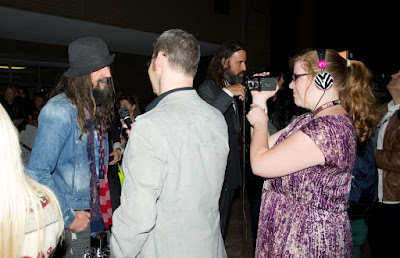Director & Writer Nick Simon
The Girl in the Photographs is set to have it's world premiere at the 2015 Midnight Madness program. The film was co-written and directed by Nick Simon. The film also has the amazing Dean Cundey (Jurassic Park, John Carpenter's Halloween) as it's cinematographer. The late Wes Craven was also an Executive Producer on the picture. I recently had the opportunity to speak with Mr. Simon about the movie. -- Robert A. Mitchell
You were born in Sioux Falls, South Dakota. What initially drew you to film making and how did you pursue this passion?
What drew me to film initially was just how big it all seemed. I was four years old when I saw Star Wars for the first time and that changed my life. It wasn’t until I saw the poster for Escape from New York that I became obsessed with film. That film was my gateway into the genre. Growing up in the 80’s and being adverse in all things sports, the cinema quickly became my church. My mother is a big fan of horror and true crime novels about serial killers. That had a huge impact on me as well. I purchased more than a few copies of Halloween and A Nightmare On Elm Street on VHS when I was a kid. The tapes kept wearing out.
Where did the idea for The Girl in the Photographs come from?
Where did the idea for The Girl in the Photographs come from?
Oz Perkins and I started working on The Girl In The Photographs right after we completed my first film, Removal. It was always sort of a hobby spec script that we kept going back to. We both went on to write other scripts while continuing to revisit Girl. The initial idea was to try and come up with a current story that had the same pace and feel as an 80’s horror film. It wasn’t until Wes Craven read the script and loved it when it became something I actively tried to get made.
The still I have seen for the film looks very haunting and ominous. What was the look you wanted to bring to the film?
Capturing the look and feel and tone of the picture was extremely important to me. I really wanted this picture to feel like the films I loved growing up. I wanted to be very specific about where the camera was pointed at all times, yet still give the picture a moodier look while being beautiful at the same time. Hiring the right cinematographer was essential to the process.
You worked with legendary cinematographer Dean Cundey (Halloween, Jurassic Park) that must have been an incredible experience. What was it like to work with Mr. Cundey?
I’ve described working with Dean Cundey as a biblical experience. Every day in prep and on set was like a master class in cinema. When I first approached Dean to shoot the picture, I remember saying to him, “I can hire a DP and show him all of your films, or you could shoot this picture!” Luckily, he loved the script and understood what I was trying to achieve. I hope to work with Dean again. He shot some of my favorite films of all time.
Wes Craven was an Executive Producer of the film. As you have said he was your mentor. Could you share something that Mr. Craven imparted on you about film making and life?
Wes was instrumental in getting this picture made. He was there every step of the way. He had some ideas on a few script tweaks, he was involved in casting, every day he would watch dailies of our principle photography and gave me weekly notes on the edit. His notes during editing were always geared towards what the audience will see and learn in each scene. He was very aware of how people watch horror films. Wes is a master filmmaker and having that kind of feedback was invaluable. He is one of the reasons that I am making film and his work has been such a huge influence on me. This film is for Wes. I’m happy that he wasn’t disappointed and loved the picture in the end.
What kind of cinematic experience awaits the audience of The Girl in the Photographs?
We all worked very hard to give the audience a throwback horror/thriller with modern story elements. I’m hoping that the audience enjoys the film and they are able to laugh as well as be terrified. I hope they will see the influence and impact that the horror films of my youth had on me.
Originally Appeared 9/11/15 Midnight Madness Blog
Originally Appeared 9/11/15 Midnight Madness Blog

